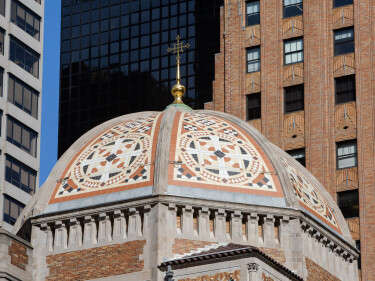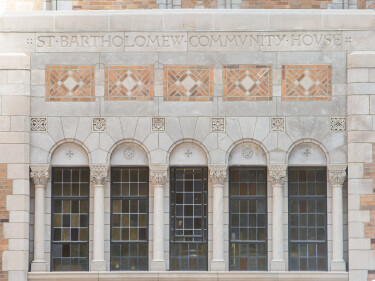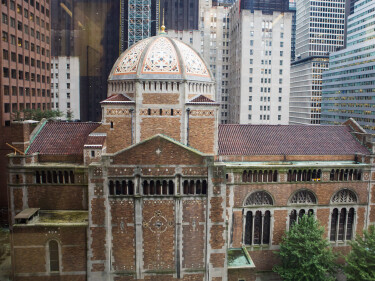A Brief History of St. Bart's
Founded in January 1835, in the then-fashionable Bowery section of Manhattan, St. Bartholomew’s began its life as part of the Evangelical movement in the Episcopal Church. Worship services were held in a plain church at the corner of Great Jones Street and Lafayette Place. At first growth was slow, but by 1872 St. Bartholomew’s was large and prosperous enough to build a splendid new church at Madison Avenue and 44th Street. Designed by James Renwick, the architect of St. Patrick’s Cathedral, the building was later embellished with a triple portal by Stanford White.
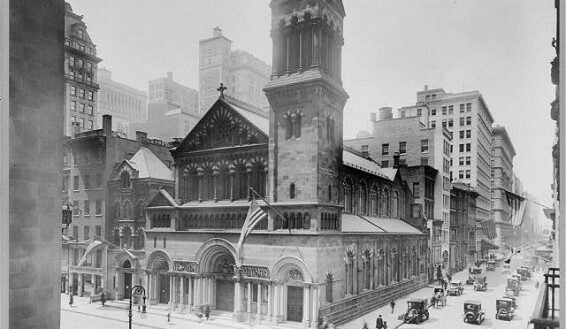
It was from the Madison Avenue pulpit that the Reverend David H. Greer, called as rector in 1888, inspired the parish to become a major force for social welfare in the city. During the enormous immigration of the late 19th century, St. Bartholomew’s huge parish house on 42nd Street (built with the support of the Vanderbilt family), ministered to large numbers of the new arrivals, who lived in appalling poverty in the tenements of the East ’40s and ’50s.
The parish house included a gymnasium, kindergarten, laundry, print shop, employment bureau, loan association, social clubs and a chapel offering services in languages other than English for the benefit of various immigrant groups. A clinic eventually expanded into a small hospital.
St. Bartholomew’s also became a force in the musical life of the city and the wider church. Under the leadership of organist Richard Henry Warren, a full choir of men and women became famous. Leopold Stokowski, who went on to a career as one of the world’s great conductors, was brought from Europe in 1905 by St. Bartholomew’s to direct its choir.
Over time, serious structural problems developed in the Madison Avenue building, so the parish commissioned Bertram Goodhue to design a new church on Park Avenue between 50th and 51st streets. In 1918, the parish moved into the new building, which was built in the Romanesque style and provided a harmonious setting for the Stanford White portal which had been brought from the old building. As funds and materials were available, the interior was decorated in the Byzantine style with major mosaics in the narthex and over the high altar.
In the 1920s, as the neighborhood changed, immigration slowed and tenements gave way to apartment houses and offices, the parish house and hospital on 42nd Street were closed.
The community house, adjacent to the church, at 50th Street, was designed by Bertram Goodhue’s successor firm and opening in 1927. It was the vision of the Reverend Robert Norwood, rector from 1925 to 1932, to minister to the growing number of young professionals flocking to the city. A poet and prophet, Norwood was a dynamic preacher who brought large crowds to the church week after week.
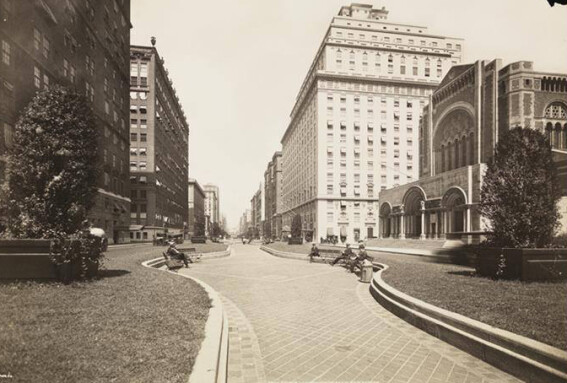 Well into the 1960s, St. Bart’s was one of the three or four largest congregations in The Episcopal Church. As its immediate neighborhood changed from primarily residential to corporate and commercial, the parish ministry increasingly reached out to the community and non-members. The music ministry included more public concerts, and St. Bartholomew’s took the lead in midtown launching substantial outreach to those in need.
Well into the 1960s, St. Bart’s was one of the three or four largest congregations in The Episcopal Church. As its immediate neighborhood changed from primarily residential to corporate and commercial, the parish ministry increasingly reached out to the community and non-members. The music ministry included more public concerts, and St. Bartholomew’s took the lead in midtown launching substantial outreach to those in need.
In 1980, a proposal to build an office tower on the site of the adjacent community house sparked a long and complex legal battle over the landmark status of the St. Bartholomew’s buildings, becoming a defining moment in the national conversation between faith communities and historic preservation.
Over eleven years, the case advanced to the Supreme Court, which in 1991 declined to hear St. Bartholomew’s appeal of the Second Circuit decision. The parish emerged from the struggle with fewer members and limited financial resources, yet with a renewed understanding of the church’s importance as both a sacred space and a civic treasure.
A period of restoration and renewal began in 1994 with the calling of the Reverend Bill Tully, whose leadership focused on rebuilding the congregation and preserving the landmark buildings. St. Bart’s reaffirmed its mission as a house of prayer for all people and as a center for service, learning, and music in the heart of Midtown. The Reverend Buddy Stallings and the Right Reverend Dean E. Wolfe, each serving as rector in succession, carried that mission forward in their own way, strengthening the parish’s pastoral life, public voice, and its enduring commitment to excellence in worship and music. Crossroads Community Services continues to meet the needs of New Yorkers facing food and housing insecurity, while Inside Park and other initiatives extend the parish’s spirit of hospitality to the city at large.
In recent years, St. Bart’s has invested more than twenty million dollars in the restoration of its historic buildings, including the Great Dome, North Façade, and Community House. Guided by a comprehensive facilities plan, upcoming projects will address the renewal of the West Façade and Triple Portal, as well as vital upgrades to mechanical and electrical systems to preserve the church for generations to come.
In 2016, St. Bartholomew’s Church was designated a National Historic Landmark.
Today, St. Bart’s continues to embody a generous faith, welcoming all, celebrating beauty through worship and music, and engaging the world with compassion and intellect from the heart of New York City.

